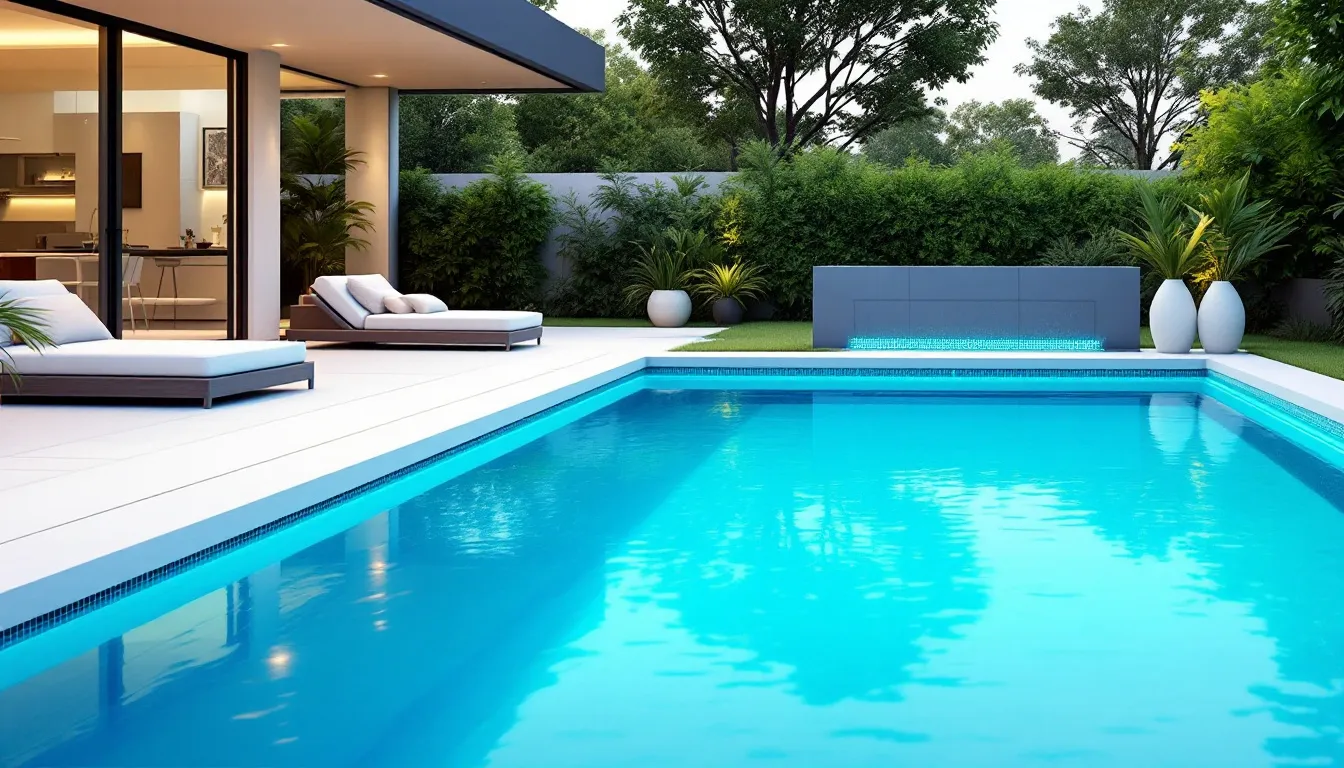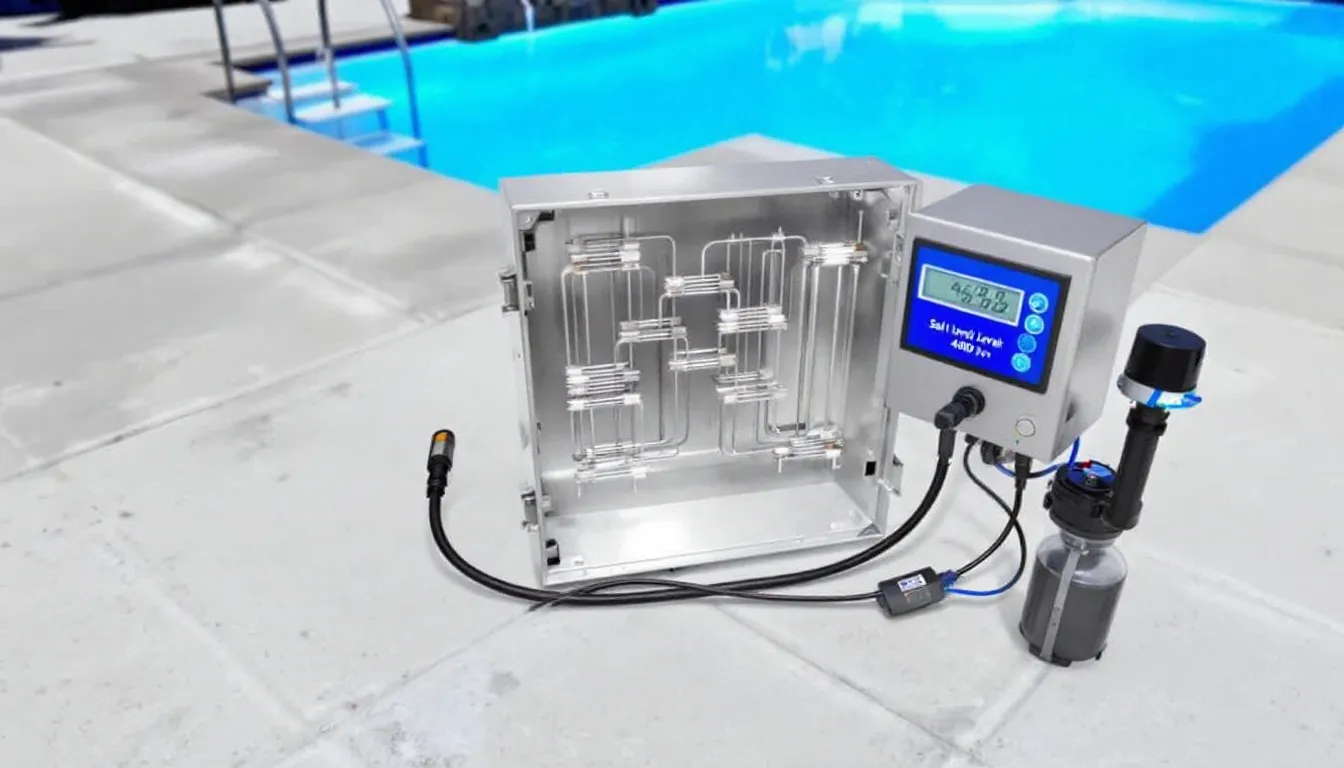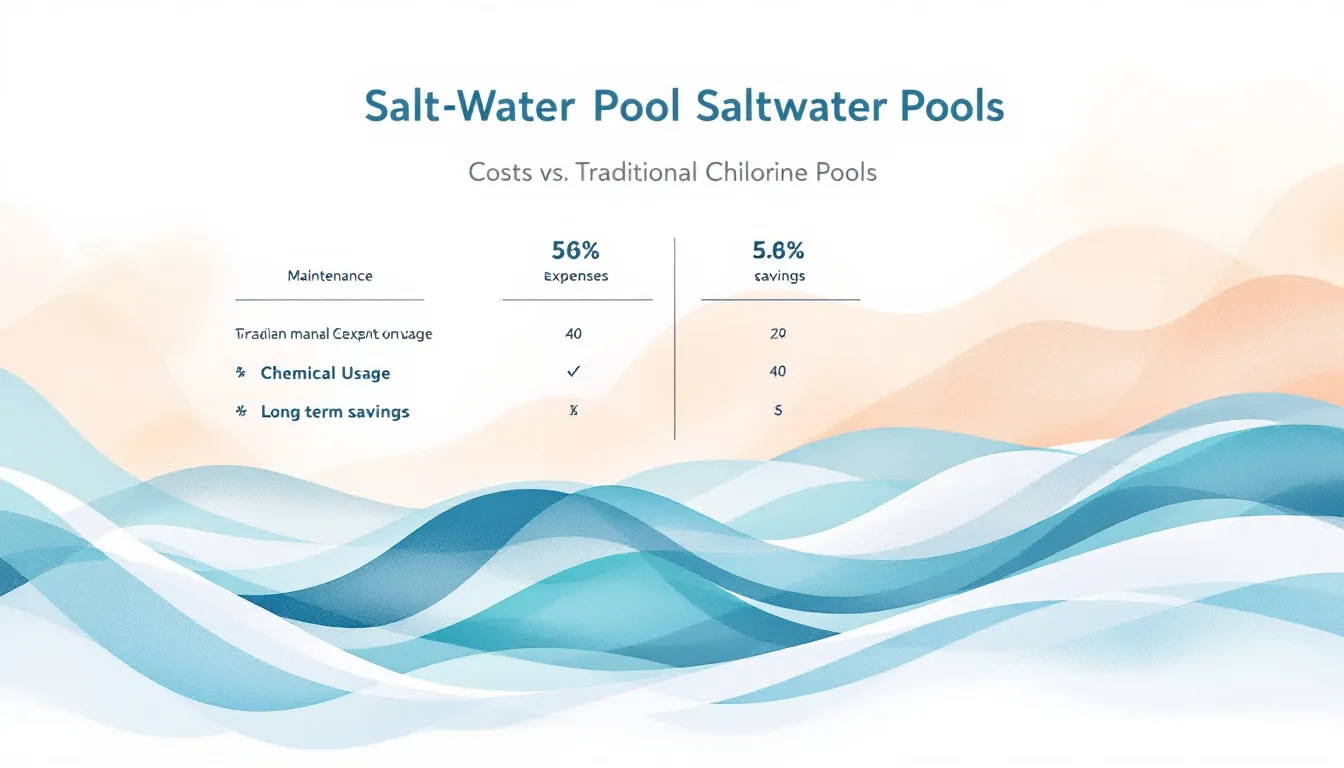
Top Benefits of Salt Water Chlorination for Residential Swimming Pools
Key Takeaways
Salt water chlorination continuously produces chlorine through electrolysis, reducing the need for manual chemical handling and storage.
Saltwater pools minimize skin and eye irritation due to lower salinity levels and provide a more enjoyable swimming experience.
Choosing the right salt chlorine generator based on pool size and usage is crucial for effective sanitation and maintenance.
Understanding Salt Water Chlorination

Salt water chlorination is a fascinating process that transforms ordinary salt into a powerful sanitizer for your pool. Unlike traditional pools that require manual addition of chlorine, saltwater pools use a salt chlorine generator, saltwater chlorine generators, and salt chlorinators to continuously produce chlorine from dissolved salt. This process, known as electrolysis, splits salt molecules to generate chlorine gas and hypochlorous acid, both of which are effective at sanitizing pool water.
One of the significant advantages of saltwater chlorination is the consistent production of free chlorine, ensuring that your pool remains clean and safe with minimal manual intervention. The electrolytic cell in the chlorinated chlorinator performs this task, meaning you no longer need to handle or store large amounts of chlorine. The ideal saline concentration for effective chlorination is below 3500 parts per million, which is much lower than ocean water, making it gentle on the skin and eyes. Understanding water chemistry can further enhance your chlorination process with salt cells.
Moreover, salt chlorination systems help reduce the presence of chloramines, the compounds responsible for the pungent smell and irritation often associated with traditional chlorine pools. Saltwater pools continuously break down these irritants, offering a more pleasant swimming experience without the harsh effects of conventional pool chemicals and salt systems. Salt water pool systems provide an effective alternative for maintaining clean and clear water.
Key Advantages of Salt Water Pools
Saltwater pools offer benefits beyond basic chlorination, including lower chlorine levels that significantly minimize skin and eye irritation for swimmers. This makes a dip in the swimming pool a much more enjoyable experience, especially for those with sensitive skin or allergies who want to swim.
The benefits of saltwater pools include:
Much lower salinity than ocean water, making it less harsh and more appealing for regular use.
Water that feels softer and more pleasant on the skin compared to traditional chlorine pools, providing a spa-like experience right in your backyard.
Reduced need for harsh chemicals, which means saltwater pools generally require less frequent maintenance, saving time and effort for pool owners.
From a maintenance perspective, the automated chlorination process of saltwater pools ensures sanitation with minimal manual intervention, reducing the need for constant chemical adjustments. This not only simplifies pool care but also extends the lifespan of pool equipment by preventing the corrosive effects of high chemical concentrations.
Choosing the Right Salt Chlorine Generator
Selecting the appropriate salt chlorine generator is crucial for ensuring your saltwater pool functions efficiently. The generator must be capable of producing enough chlorine to keep the pool sanitized, based on the pool’s size and usage patterns. For heavily used pools, a generator with higher chlorine output is essential to maintain water quality.
The surrounding environment, weather conditions, and local climate can affect chlorine demand. Pools in warmer climates or areas with high vegetation may require access to a generator with a higher output to compensate for increased microorganism growth, heat, and money, often measured in gallons.
Choosing a generator with varying chlorine output capacities ensures your pool remains clean and safe under different conditions, making it the ideal choice for maintenance.
Pool Size and Chlorine Output
Matching the capacity of a salt chlorine generator to your pool’s size is crucial. To ensure adequate sanitation:
The generator must be rated to produce 1.5 to 2 times the chlorine output needed for your pool.
Consider the total volume of your pool.
Select a generator that can handle this capacity efficiently.
Choosing the wrong chlorine output can result in inadequate sanitation and higher maintenance issues, both costly and time-consuming. Therefore, selecting a generator that meets or exceeds your pool’s requirements is critical for maintaining a healthy and enjoyable swimming environment.
Installation Considerations
Choosing an easy-to-install salt chlorination system can save significant time and effort. High-quality products like CircuPool are known for their durability and user-friendly design, simplifying installation. Features such as clear instructions, fingerprint readers, and bi-directional flow switches further simplify the process.
Many installations can be completed in under an hour, especially when using appropriate adapter kits to adapt to existing pump setups. The CircuPool CORE Series, for example, can be installed in as little as 10-15 minutes. Self-installation is a viable option without voiding warranties, making it an attractive choice for many pool owners.
Evaluating Features
Consider features that enhance ease of use and low maintenance when evaluating salt chlorine generators. A self-cleaning feature can significantly reduce the time you spend on maintenance. Digital controls and diagnostic information are essential for efficient operation, allowing easy monitoring and adjustment of chlorine levels.
Advanced models with remote control capabilities and smartphone app control provide convenience and flexibility in managing your pool. Systems like the Pentair IntelliChlor Series are a popular choice for their advanced pool automation systems features, ensuring seamless integration with your pool’s existing setup.
Maintenance Tips for Saltwater Pools

Regular monitoring and upkeep of a saltwater pool ensure optimal performance. Monitoring salt levels, typically ranging from 1000 to 4000 parts per million, is crucial. Regular inspections of all pool components are essential for pool maintenance to ensure everything operates smoothly and efficiently.
Regularly checking salinity levels ensures effective chlorine production and overall pool health. This not only helps maintain water quality but also extends the lifespan of your pool equipment by preventing damage from improper salt levels.
Balancing Salinity Levels
Maintaining the ideal salinity levels in your saltwater pool is key to achieving efficient chlorination. The optimal range typically falls between 2700 and 3400 parts per million, with the best results around 3000 to 3500 ppm. Ensuring that your pool stays within this range helps produce the right amount of chlorine to keep the water clean and safe.
Maintaining salinity involves regular water testing and adding pool salt as needed to keep levels within the optimal range. Salty rainfall and water evaporation can affect salinity levels and require adjustments.
Preventing Corrosion
Corrosion is a common concern for saltwater pools, as salt can damage metals and other materials. Using sacrificial anodes can effectively prevent corrosion. These anodes corrode instead of your pool’s hardware, providing a protective measure.
Regular inspections help identify early signs of corrosion and allow for timely regular maintenance. This helps extend the lifespan of your pool equipment and ensures that everything continues to function properly despite the presence of salt in the water.
Addressing Calcium Buildup
Calcium buildup can significantly impact the performance of your salt chlorinator. Routine cleaning of electrolytic cells prevents calcium deposits from affecting performance. Regular descaling helps maintain the efficiency of the chlorinator, ensuring that it continues to produce chlorine effectively.
Managing calcium buildup involves regularly inspecting and cleaning the salt cell. This prevents deposits from accumulating and ensures that your chlorinator remains in good working condition, providing consistent sanitation for your pool.
Cost-Effectiveness and Sustainability

A saltwater pool system can be a cost effective solution in the long run for the following reasons:
Although the initial cost may be higher, long-term savings on chemical costs can offset these expenses.
Saltwater pools require fewer chemicals.
This means lower ongoing maintenance costs.
Saltwater pools are also a sustainable choice from an environmental perspective. They use fewer harsh chemicals, reducing chemical runoff and minimizing environmental impact. The continuous production of chlorine by the generator also reduces the need for chemical handling and storage, further enhancing safety and convenience.
Common Issues and Solutions
Maintaining the correct salt levels is a common issue with saltwater pools. High salt levels can reduce the efficiency of the chlorinator and cause potential damage to pool equipment. Draining and diluting the pool water is the solution for high salt levels, bringing it back within the optimal range.
The occasional need for additional chlorine arises during periods of heavy use or extreme weather conditions. Manually adding chlorine ensures the pool remains clean and safe for swimming during these times. Regular monitoring and adjustments can help prevent these issues from becoming significant problems.
Summary
In summary, saltwater pools offer numerous benefits, from lower maintenance requirements to a more pleasant swimming experience. Understanding the basics of salt water chlorination, choosing the right salt chlorine generator, and following proper maintenance practices are key to enjoying these benefits.
By making the switch to a saltwater pool, you not only improve your swimming experience but also contribute to environmental sustainability and long-term cost savings. Embrace the future of pool care and dive into the refreshing world of saltwater pools today.
Frequently Asked Questions
What is the ideal saline concentration for saltwater pools?
The ideal saline concentration for saltwater pools is generally between 3000 and 3500 parts per million, ensuring effective chlorination and optimal pool performance.
How does a salt chlorine generator work?
A salt chlorine generator effectively sanitizes your pool by using electrolysis to convert dissolved salt into chlorine gas and hypochlorous acid. This process ensures a continuous supply of chlorine for maintaining clean and safe water.
Are saltwater pools easier to maintain than traditional pools?
Saltwater pools are easier to maintain than traditional pools because they automate the chlorination process, leading to less frequent upkeep. This can save you time and effort in pool care.
Can I install a salt chlorine generator myself?
Yes, you can install a salt chlorine generator yourself as many models are designed for easy installation, and this typically does not void warranties.
How do I prevent calcium buildup in my saltwater pool?
To prevent calcium buildup in your saltwater pool, regularly clean and descale the electrolytic cells to maintain their efficiency. This proactive approach will help ensure your pool stays in optimal condition.



